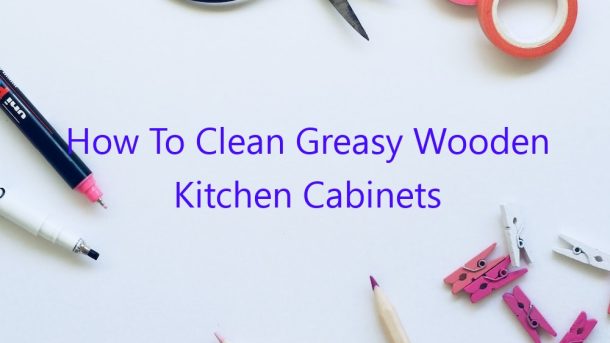Grease and oil can be a real pain to remove from wooden cabinets, but with the right approach, it can be done. Here is a step-by-step guide on how to clean greasy wooden kitchen cabinets:
1. Begin by scraping off as much of the grease and oil as possible using a blunt object, such as a butter knife.
2. Next, mix together 1/4 cup of baking soda with 1/4 cup of water to create a paste.
3. Apply the paste to the greasy areas of the cabinet and let it sit for 10-15 minutes.
4. Use a wet cloth to scrub the paste away, then rinse with water.
5. Finally, dry the cabinets with a clean cloth.
Contents [hide]
How do you remove greasy residue from kitchen cabinets?
Greasy residue can be a nuisance to remove from kitchen cabinets, but with the right approach it can be done. The first step is to identify the source of the grease. If the grease is coming from cooking oils or fats, it can be removed with a commercial degreaser. If the grease is coming from food spills, it can be removed with a degreaser or a mixture of warm water and dish soap. Once the grease is removed, the cabinet surfaces can be cleaned with a non-abrasive cleaner.
How do you degrease wood cabinets?
Cleaning wood cabinets can seem like a daunting task, but it’s actually quite simple. The first step is to degrease the cabinets with a safe and effective degreaser.
There are a few different ways to degrease wood cabinets. One way is to use a commercial degreaser, such as TSP (trisodium phosphate) or Lime-A-Way. These products are available at most hardware stores.
Another way to degrease wood cabinets is to use a natural degreaser. One of the most popular natural degreasers is white vinegar. White vinegar is a safe and effective degreaser that can be used on most surfaces.
To use white vinegar as a degreaser, simply pour it into a spray bottle and spray it on the cabinets. Let the vinegar sit for a few minutes, then wipe it away with a clean cloth.
If you don’t have white vinegar, you can also use lemon juice as a degreaser. Simply pour lemon juice onto a cloth and wipe it on the cabinets. Let the lemon juice sit for a few minutes, then wipe it away with a clean cloth.
Once the cabinets are degreased, you can clean them with a safe and effective cleaner. There are many different types of cleaners available, but I recommend using a mild detergent, such as dish soap.
To clean the cabinets with dish soap, simply mix the soap with water in a bowl, then dip a clean cloth into the mixture. Wipe the cabinets with the cloth, then rinse the cloth in clean water and wipe the cabinets again.
If you have any tough spots or stains on the cabinets, you can use a stronger cleaner, such as bleach. However, I recommend using bleach sparingly, as it can be harmful if used incorrectly.
To use bleach to clean wood cabinets, mix it with water in a spray bottle. Spray the bleach on the cabinets, then let it sit for a few minutes. Wipe the cabinets with a clean cloth, then rinse the cloth in clean water and wipe the cabinets again.
Once the cabinets are clean, dry them with a clean cloth.
Cleaning wood cabinets can be a challenging task, but it’s definitely worth it in the end. By degreasing the cabinets and using a safe and effective cleaner, you can make your cabinets look like new again.
What is the best thing to use on greasy kitchen cabinets?
Cleaning greasy kitchen cabinets can seem like a daunting task, but it doesn’t have to be. There are a few different things you can use to clean your cabinets and make them look new again.
One option is to use a degreaser. A degreaser is a type of cleaner that is specifically designed to remove grease and oil from surfaces. There are a few different degreasers that you can buy, or you can make your own by mixing vinegar and water.
Another option is to use a household cleaner. There are a few different types of household cleaners that you can use, such as bleach, ammonia, or a dishwashing detergent. Be sure to read the label of the cleaner before using it to make sure that it is safe to use on kitchen cabinets.
Finally, you can use a natural cleaner. There are a few different natural cleaners that you can use, such as vinegar, baking soda, or lemon juice. Be sure to read the label of the cleaner before using it to make sure that it is safe to use on kitchen cabinets.
No matter what type of cleaner you choose to use, be sure to test it in a small area first to make sure that it does not damage the finish of your cabinets.
What is a good degreaser for wood cabinets?
A degreaser can be a lifesaver when it comes to cleaning wood cabinets. Whether your cabinets are made of natural wood or are covered in a layer of grease and grime, a degreaser can help to break down the dirt and make cleaning much easier.
When looking for a degreaser to use on wood cabinets, it’s important to find one that is safe to use on this type of surface. Many degreasers are designed for use on grease and grime, so it’s important to read the label before using. In general, degreasers that are citrus-based or ammonia-based are safe to use on wood cabinets.
To use the degreaser, spray it onto the surface of the cabinets and let it sit for a few minutes. Then, use a damp cloth to wipe the cabinets clean. Be sure to rinse the cabinets with water afterwards to remove any traces of the degreaser.
Why are my wood cabinets sticky?
One of the most common issues with wood cabinets is that they can become sticky. There are several reasons this might happen, and fortunately, there are also several solutions. In this article, we will explore the causes and solutions for sticky wood cabinets.
The first step in solving the problem is to identify the cause. There are several reasons why wood cabinets might become sticky, including:
-Excessive humidity
-Excessive heat
-Dust and dirt
-Oil and grease
Each of these causes requires a different solution, so it is important to identify the cause before trying to fix the problem.
If the cabinets are sticky because of excessive humidity, the solution is to reduce the humidity in the room. You can do this by using a dehumidifier, or by opening the windows to let the humidity escape.
If the cabinets are sticky because of excessive heat, the solution is to lower the temperature in the room. You can do this by turning on the air conditioning, or by using a fan to create airflow.
If the cabinets are sticky because of dust and dirt, the solution is to clean them. You can do this by using a wet cloth, or by using a cleaning product specifically designed for wood cabinets.
If the cabinets are sticky because of oil and grease, the solution is to remove the oil and grease. You can do this by using a cleaning product specifically designed for this purpose, or by using a household cleaner such as Murphy’s Oil Soap.
Once you have identified the cause of the problem, you can take the appropriate steps to fix it. If you are not sure how to fix the problem, you can consult a professional. With a little bit of effort, you can get your wood cabinets back to their original condition.
Can you use Dawn dish soap on wood cabinets?
Can you use Dawn dish soap on wood cabinets?
There is no definitive answer to this question as Dawn dish soap is a powerful cleaner that can potentially damage wood cabinets. However, some people claim to have successfully used Dawn dish soap to clean their wood cabinets without any adverse effects. If you decide to try using Dawn dish soap to clean your wood cabinets, be sure to test it in a small, inconspicuous area to make sure it does not damage the finish.
Why are my kitchen cabinets sticky after cleaning?
If your kitchen cabinets are sticky after cleaning, it could be due to a variety of reasons. In some cases, the cabinets may be dirty, and in other cases, the cabinets may be damaged.
If your cabinets are dirty, you may need to clean them more thoroughly. Use a degreaser or a vinegar and water solution to clean the cabinets. Be sure to rinse the cabinets thoroughly after cleaning.
If your cabinets are damaged, you may need to repair them. Damaged cabinets can be caused by water damage, heat damage, or humidity. If your cabinets are damaged, you may need to replace them.




